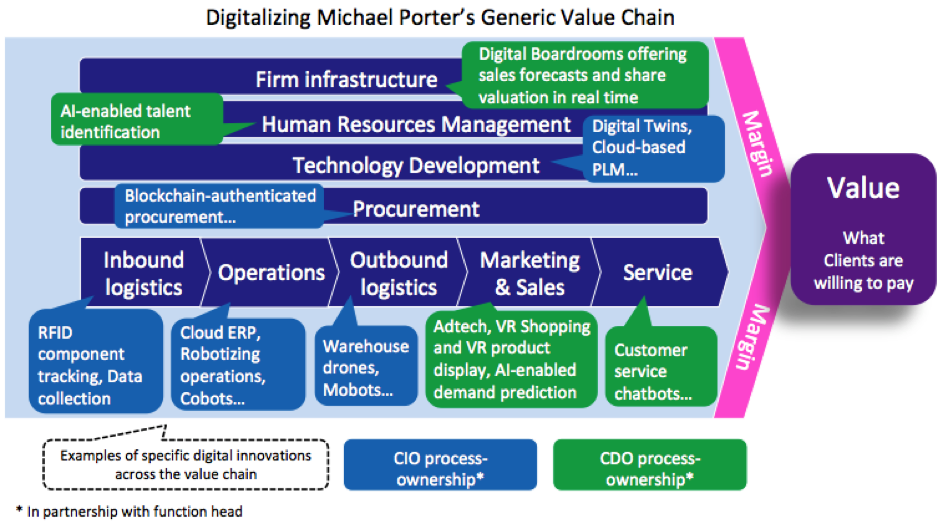How should Senior Leader transform their organizations to capture the $1210 Billion in value? Should they consider changing their company’s business model, hire new talent or invest in specific set of technologies? To address these issues, I draw on conversations with C-level executives in addition to Goldman Sach’s equity research.
The implications for CEOs, COOs and CFOs
In the short-term, “innovation is a share valuation booster”, as Luka Mucic, CFO of SAP once told me during an interview for The Innovation and Strategy Blog. Simulated the added earnings per share (EPS) acquired through cost reduction and comparing it to incremental EPS gained with revenue-generating activities (like innovation) shows that, in profitable sectors, pursuing the latter almost always ends up creating higher EPS.
Plus, Senior Leaders of large B2B corporations should digitalize their business. Pierre Petetin, CFO of Vidal Group, a 200 ME healthcare information player, thinks that digital transformation lifts enterprise valuation. In most industries, a company’s valuation stands at EBITDA multiplied by 4 while their digital counterparts go for EBITDA times 15.
At a broader level, Senior Leaders may look at the following:
- Considering that shareholder value creation should reach $6 trillion dollars, how much would they like to claim?
- What share do they want to capture out of the $1210 billion at stake: 1%? 10%? 50%? Nothing? How much? In what way does current resource allocation reflect stated goals?
- What can Senior Leaders do now to steer their corporation in a direction conducive to growth?
These questions may appear very generic but they serve as a meaningful guide to select C-level priorities in an otherwise crowded agenda. Plus, they offer the advantage of uncovering the tremendous potential for digital enabled development. In any case, we’ll delve into these issues in forthcoming articles.
The implications for CIOs and CDOs
Maximizing shareholder value implies digitalizing the value chain. What does that mean? From resource acquisition, operations, marketing, sales and distribution, each moment in the value chain must become fully digital. Here’s a visual overview:

The process-ownership breakdown pictured above exemplifies how both CDOs and CIOs are overhauling the value chain. Such a distribution depends on corporate culture and may vary from company to company. The key takeaway remains: digital technologies hold the potential to optimize every single segment of the value activity. Marc Andreessen once told the Wall Street Journal that “software is eating the world”. Clearly novel technologies are revamping production chains.
The implications for Operations leaders
In operations, Smart factory technologies combining the Cloud and the Internet of Things ascertain the location of industrial assets. Plus, they provide capacity utilization information while conducting predictive maintenance increasing productivity.
Purchasers still using email and snail mail to place resource acquisition orders may consider platforms to complete an order. Traditional purchasing only deals with first-level suppliers—those entertaining a direct relationship with the company—leaving clients unaware of where components and raw materials are sourced. In a time when sustainable development and brand image are tightly linked to one another, bearing responsibility for the entire supplier chain—from raw materials to IP-intensive components—proves crucial. A Blockchain enabled supply chain authenticates externally acquired components going into products. This enhances overall quality and bolsters consumer confidence, allowing for increased differentiation against competition while building a foundation for commanding premium prices.
In addition, Bruno Delahaye, VP Channel Marketing Value Solutions at Dassault Systèmes, recently told me that the Paris-based company is creating a “platform helping clients identify best supplier prices.”
The implications for the Chief Marketing Officer
Digital marketing provides a new medium for reaching out to consumers and a transformative opportunity for B2B players. Industrial corporations have often acquired little experience in engaging end users as they have relied on third parties for lead generation and demand qualification. François Darchis, Senior Vice President, Innovation and Development Vice President in charge Information Technologies, the Industrial Merchant business line and the Group’s Sustainable Development program at Air Liquide, an industrial gaz leader, told me during an interview for The Innovation and Strategy Blog that “digital technologies help Air Liquide address end consumers directly”, thereby disintermediating traditional distribution partners. There’s room for evolving from mass production to mass personalization.
The advisor to Capgemini’s CEO and a member of EDF’s board, Colette Lewiner told me about Eneco’s novel services combines green electricity with innovation. Customers get a “free energy box allowing them to track and control their consumption. By implementing these types of online offers, Utilities can improve their efficiency, in particular by simplifying their IT system, decreasing call center size, increasing client satisfaction, and decreasing client churn.”
The implications for Chief Sales Officer
Finally, in terms of distribution, the sales process is undergoing profound change. In the automobile industry, car manufacturers are developing a direct relationship with their consumers. Instead of having to go through retailers, they target prospects and may recommend a specific retailer to the buyer. Client data is becoming more prevalent. A deeper cultural implication is at play. Digital technology abolishes the boundaries of space and time. To quote the New York Times editorialist, Thomas Freedman, the Internet is making our “world flat”: information stands available to everyone in the value chain. The consumer appears ubiquitous; anyone in the organization can reach out to him.
To sum up: digital technologies maximize efficiencies across the value chain and boost market cap
So this illustrates how High Tech enhances productivity. Senior Leaders may want to review their existing project portfolio and concentrate on digital innovations because they maximize efficiency across the value chain and lift corporate valuation.
In the next article, I’ll talk about how value is distributed across the seven digital technologies.
No comment